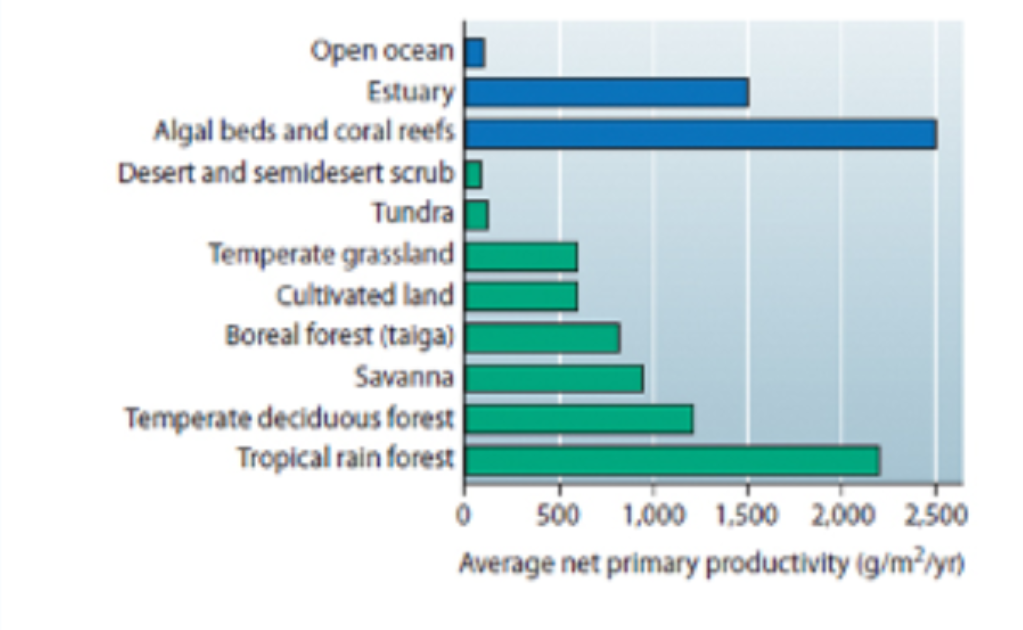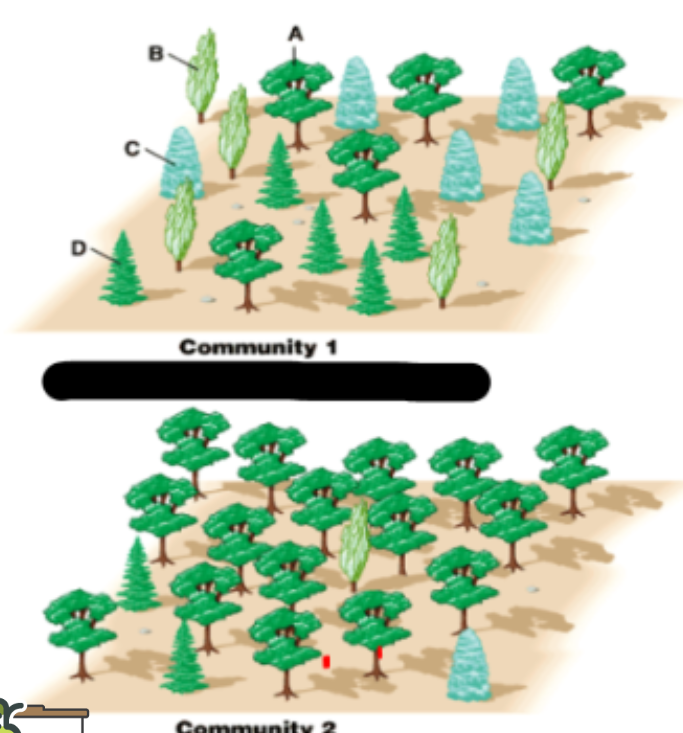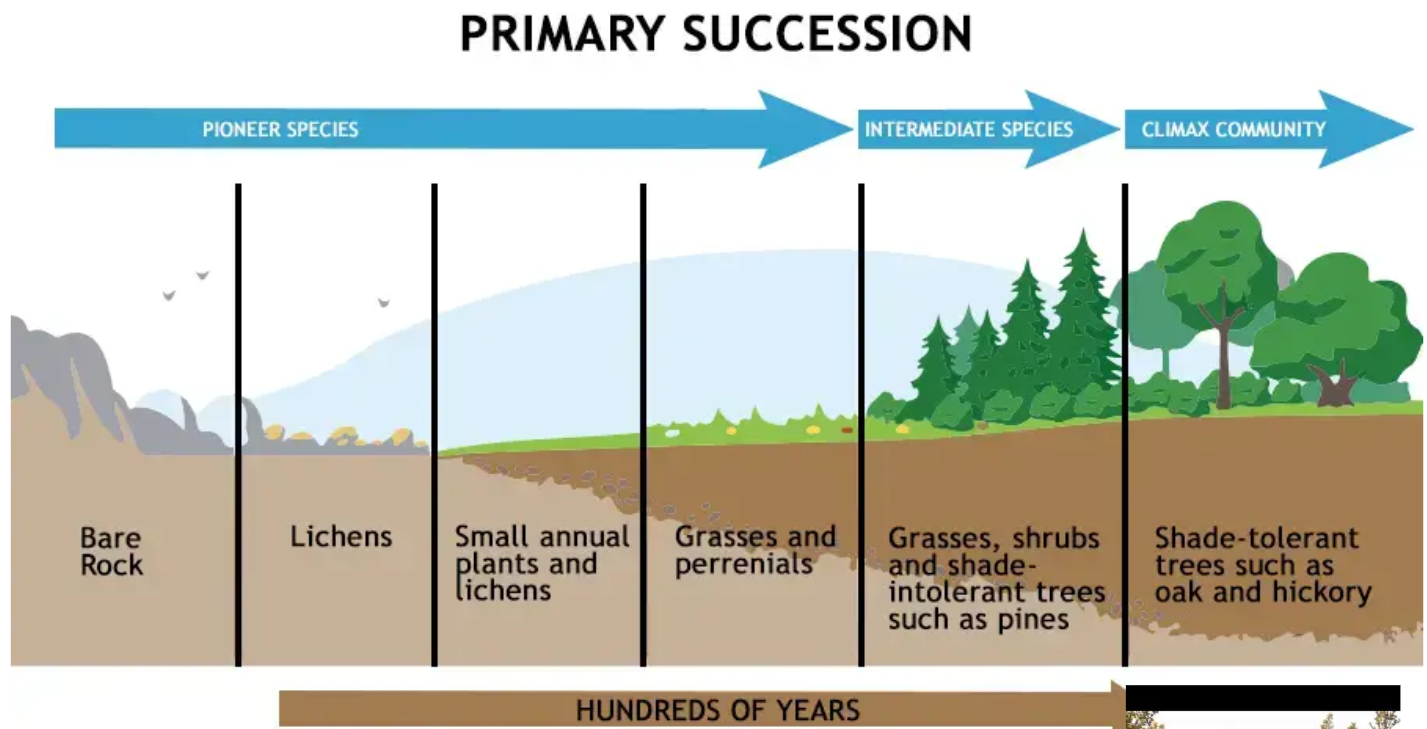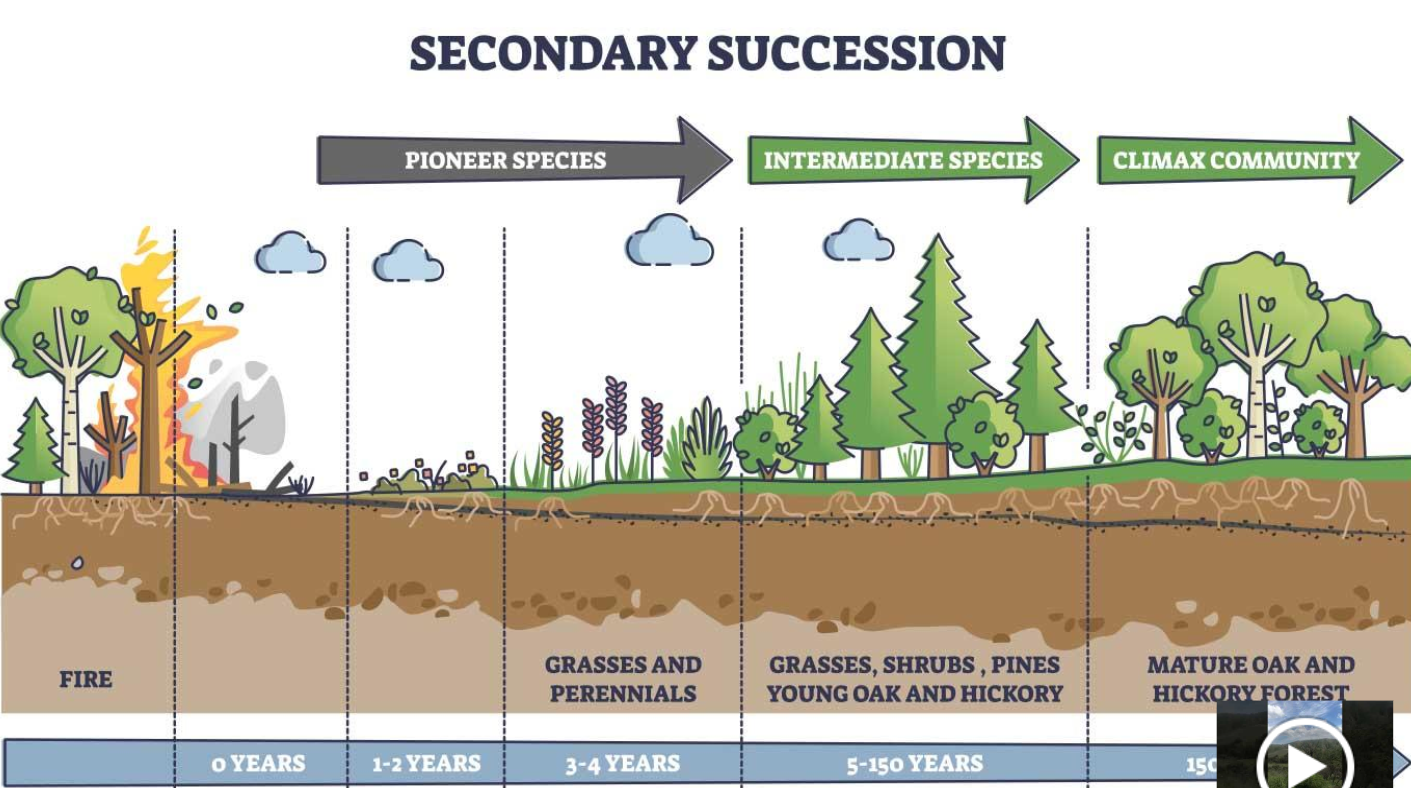Unit 8: Biodiversity Study Guide
Introduction
For most ecosystems, the ultimate source of energy is the sun
However, not all ecosystems absorb the same amount of energy
The amount of energy absorbed (amount of photosynthesis being done) in an ecosystem is referred to as primary production

Vegetation refers to the number of plants on land
A higher (darker) vegetation index generally indicates a higher rate of photosynthesis
Chlorophyll is the name of the green pigment that plants use to make food during photosynthesis
A higher chlorophyll concentration generally leads to a higher rate of photosynthesis

A higher biodiversity leads to greater overall productivity

Formation of Biomes
The amount of water available and the temperature in a biome determine what type and abundance of plants can grow (depends on latitude and altitude)
More sunlight = More productivity
More productivity = More biodiversity
Biomes and Climate
Earth’s tilted axis causes seasons as it revolves around the sun
Weather: Day-to-day conditions at a particular place and time
Climate: Average, year-after-year conditions in a region
There are 3 main climate zones
Polar = Cold areas
Temperate = Hot/cold seasons
Tropical = Always warm
Tropical Rainforest
Has the most species (biodiversity)
Canopy = Top
Understory = Below the canopy
Hot and wet year-round; poor soil
Arboreal = an animal that lives in trees
Brachiation = movement by swinging
Savanna (Tropical Grassland)
Grassland area, with a few trees
large animal herds and frequent fires
Lions, Sebra, Wildebeest, Gazelles, Elephants, Giraffes
Desert
Dry (less than 25 cm of rainfall each year)
Extreme temperature changes (hot/cold)
Cacti/succulent plants
Organisms able to tolerate extreme conditions
Temperate Grassland (Plains and Prairies)
Midwest, very fertile soil
4 seasons: Seasonal precipitation
Deer, Prairie dogs, Coyotes, Songbirds, Raptors, Snakes
Chaparral
Dominated by shrubs, frequent fires
Example: Los Angeles, CA
Temperate Deciduous Forest (Eastern portion of US)
Deciduous trees, 4 seasons
Seasonal rainfall
Trees: Maple, elm, oak, pine
Animals: squirrel, songbirds, rabbits, owls, snakes, reptiles, raptors, rodents
Boreal Forest (Taiga)
Evergreen forests
Cold, long winters
Short, mild summers
Known as the coniferous forest in the US
Tundra
Permafrost = layer of permanently frozen subsoil
Strong winds: no trees, small plants
Plants = mosses, lichens, grasses
Animals = Arctic fox, Caribou
Freshwater
Flowing: water ecosystem, rivers, streams, creeks
Standing: water ecosystem, lakes, ponds
Trout, herons, eagles, bass, bluegill, crayfish, water snakes, turtles
Estuary = where freshwater meets sea
Wetlands = water covers soil (marshes and swamps)
Marine
Photic zone: area sunlight reaches
Aphotic zone: permanently dark
Plankton: microscopic organisms found in water
Sharks, whales, dolphins, fish, anemones, squid, seagulls, pelicans, crabs, shrimp
What is Biodiversity?
Biodiversity is the number and variety of different species in an ecosystem
First coined by Walter G. Rosen in 1985, biological diversity (biodiversity) is defined as the variety of life on Earth and the natural patterns it forms
All organisms within an ecosystem are interconnected
When the diversity of organisms within an ecosystem declines, so does the ecosystem’s ability to function and survive
Ecosystems with higher primary productivity tend to have higher biodiversity
More energy is available to support a variety of organisms
Biodiversity increases near the equator for 3 reasons
More sunlight
Consistent temperature
Old (unchanging) environment
Ecosystems with higher biodiversity are better able to recover after environmental change
Diversity can happen at many levels
Species Richness vs. Species Diversity
Species Richness: total number of different species
Species Diversity: relative abundance of the different species (evenness)

Both communities are equally rich, but Community 1 is more diverse
Community 1 would be more likely to survive a forest fire because it is more diverse and can repopulate all species
Monitoring Biodiversity
Random Sampling
Technique involving plants where samples are chosen from a population by using a random number table or a random number generator
Steps to Random Sampling
Count 10 random squares (could be any number)
Find the total number of flowers counted (doesn’t have to be flowers)
Find the Average per square by dividing the total by the number of random squares
Multiply the average by the total number of squares to find the approximate number of plants in the whole area
Mark and Recapture
Technique involving animals where a portion of the population is captured, marked, released, and recaptured

Succession
Ecological succession is the process by which natural communities replace (succeed) one another over time
There are two types of succession
Primary
Secondary
Pioneer species are the first species to inhabit an area
Clmax Community is when the species replacement slows and the ecosystem stabilizes
Primary Succession
Occurs when there is new soil formation
Establishes a New Community where no life has been
Example: volcanic island

Secondary Succession
Occurs after ecosystem disturbance (forest fire, floods, farming, etc)
Starting over, but not from scratch

Species Interactions
Coevolution: Two species evolve in response to changes in each other
A symbiotic relationship is an intimate relationship between two or more species (not always positive)
Mutualism: biological interaction between 2 species where both benefit from each other
Example: Flowers and Pollinators
Commensalism: One benefits, the other is neither harmed nor benefited
Example: Whales and Barnacles
Parasitism: Feeding off of another organism (not intended to kill the host)
Example: Tapeworm in intestine
Predation: Killing and eating another organism
Example: A Cheetah hunting a Gazelle
Adaptations of Parasites
Parasites are adapted so that they receive maximum benefit from the host, but do not kill them
Suckers and hooks for attachment
Thick, resistant outer coverings
Anaerobic (if living inside the digestive tract)
Predator Adaptations
Teeth, claws, vision, strength, camouflage, and working together
Mimicry: One species resembles another as defense
Warning (Aposematic) Coloration: Conspicuous markings or bright colors possessed by an animal that serve as a warning to potential predators that it is toxic or distasteful
Individual Defense Mechanisms: How one individual stands up for themselves
Startle Behavior (blowfish)
Anatomical Defense (Porcupine)
Chemical Defense (Skunk)
Group Defense Mechanisms
Pack behavior, herding behavior (zebra), schooling fish, swarming insects